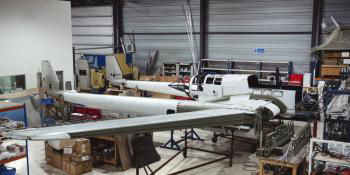With only 846 built, the chance to own a Focke-Wulf Fw189 doesn’t come along too often, especially as this example, Werksnummer 2100 is thought to the last survivor of its kind
The Fw189 usually carried a crew of three, with a maximum speed of 217mph and an operating range of just over 400 miles.
With its twin-boom, twin engine, heavily glazed design, the Fw189 was the Luftwaffe’s main reconnaissance aircraft on the Eastern Front and came to be known as “The Flying Eye”.
During the Aircraft Restoration Company’s research into the type, they came across stories of a Fw189 once returning from a sortie with a boom missing, which is testament to the sturdiness of Kurt Tank’s design. For ease of replacement in the field, both booms were interchangeable in order to minimise the number of spare parts required.
The Fw189 combined all the attributes required on the Eastern Front – strength, manoeuvrability, toughness and reliability, with the ability to operate from short and unpaved airstrips. It could capture photographs from the camera built into the fuselage and in the role of reconnaissance the type was superb.
Werksnummer 2100 was test flown twice on 23 July 1941, and then once more on 24 July. The aircraft was certified airworthy and passed to the short range army cooperation unit which would take it into action.
This aircraft is thought to be the fourth of ten Fw189s produced by Aero in Prague in 1941. It served as an army cooperation aircraft for two years leading up to its last flight, during which time it was believed to be upgraded to A2 specification.
Just after 3am on the morning of the 4th May 1943 the pilot Lothar Mothes; navigator/bombardier/gunner Kurt Lebrecht and rear gunner Gunther Albrecht took off on what would be their last mission.
The aircraft was to photograph Loukhi III Airbase from an altitude of 20,000ft and then continue north up the Murmansk-Leningrad Railway. Half an hour into the sortie a radio message was received to warn they were under heavy attack by Russian Hurricanes and that was the last communication received. Lebrecht and Albrecht died as a result of their wounds, whereas Mothes survived the ordeal, and the war. Mothes made his way behind Russian lines, living off bark from trees and grubs in order to survive, and finally reunited with German soldiers having evaded Russian soldiers for two weeks. He spent nine months in hospital and convalescing as a result of the crash, but returned to his duties as a pilot, flying a further 100 missions in Fw189s.
The wreckage was found some hours later in a forest near Loukhi, south of Murmansk, Russia. It was there, in Arctic conditions, that the aircraft remained for 52 years. Due to the inaccessibility of the site, it was recovered from the forest by helicopter and then transported to the UK by road and sea in 1992 where it was placed in storage.
Despite being a well-kept secret for many years, work on the Fw189 is well advanced. In the fuselage area of the aircraft, the forward frame is 40% complete, the central fuselage 65%, and the aft section is 75%, with the rear turret (capola) also being approximately 75% complete. The structure/skins of the centre wing and the engine nacelles are 80% complete and the fuel tank panels are 60%. The wing tips are at 40% and the starboard outer wing is 65%. Both port and starboard tail booms are 80% and the fin units are 60% complete on the port side and 80% on the starboard. Of the control surfaces, the ailerons are at 50%, the flaps at 40% and the rudders at 20%.
Priced at $1,500,000.00 U.S. Dollars (plus TAX if applicable), this unique and ongoing project is now being offered for sale and can be completed to airworthy or static condition. The investment needed to complete the project is estimated to be in the region of a further $2,000,000.00.
For more information visit www.aircraftrestorationcompany.com.











